Optimizing Hydrogen Production for Sustainable Fuel Cell Electric Vehicles: Grid Impacts in the WECC Region
Abstract
1. Introduction
- Quantifying the additional electricity demand from FCEVs and its impacts on grid operations;
- Comparing the cost implications of flexible versus inflexible hydrogen production processes;
- Exploring the benefits of oversized electrolyzers in utilizing low-cost electricity generation opportunities.
2. Methodology
- FCEV Technology Specifications and Load Characterization: We begin by introducing the technical specifications of FCEVs, including their energy requirements, and detail the process of characterizing electricity loads associated with FCEV adoption.
- Driving and Refueling Behavior Modeling: Next, we model the driving and refueling behaviors of an FCEV fleet using a V2G simulator to estimate the corresponding energy consumption. This step provides a comprehensive understanding of how FCEVs interact with energy systems during operation.
- Hydrogen Refueling Profiles and Station Allocation: We then map FCEV refueling profiles at the station level, considering spatial distribution, to allocate hydrogen refueling stations effectively. This step ensures that the hydrogen demand is distributed in a manner consistent with geographic and operational constraints.
- Electricity Grid Simulation with PLEXOS: Finally, we simulate the existing Western Electricity Coordinating Council (WECC) electricity grids using the Production Cost Model (PCM), PLEXOS. This simulation accounts for the additional electricity load introduced by FCEVs, providing insights into their impact on grid operation and cost dynamics.
2.1. Electricity Load Characterization
2.1.1. Household Electricity Consumption
2.1.2. FCEV Specification and Electricity Consumption
2.2. Hourly Demand of Hydrogen for FCEVs
2.3. Hourly Demand of Hydrogen for FCEVs in Western United States
- (1)
- Business-as-usual (BAU). This is the reference scenario for the WECC electricity grid in 2024. In the BAU scenario, we assume no electricity loads to produce hydrogen for FCEVs.
- (2)
- Flex block scenario. This scenario, on top of the BAU scenario, considers the electricity load to meet the hydrogen needs for the predicted FCEV stock. In this scenario, the capacity of electrolyzers is set to meet the hourly average hydrogen demand for FCEV refueling. Thus, over the whole year, the electrolyzers, working at full utilization (a capacity factor of 100%), could produce just the amount of hydrogen needed for the predicted number of FCEVs. For simplicity, we assume there is enough hydrogen storage in the system. This scenario offers no flexibility in electrolyzer operation, and there is no extra electrolyzer capacity to generate more hydrogen even if the hydrogen demand increases.
- (3)
- Flexible scenarios. These scenarios also consider the electricity load to meet the hydrogen needs for the predicted FCEV stock on top of the BAU scenario. In the flexible scenarios, the capacity of electrolyzers is larger than those determined in the Flex block case. This is more realistic and potentially beneficial since electrolyzers now have extra capacity to generate hydrogen at times of lower electricity costs or to meet increases in future hydrogen demand. For these series of scenarios, we use capacity factors of electrolyzes in each scenario to characterize different flexible scenarios considered. Again, we assume there is enough hydrogen storage in the system.
2.4. Modeling Hydrogen Production and Storage in PLEXOS
- (1)
- In the PSH, the head reservoir storages energy by keeping the water at a higher altitude. In our model, we use the head reservoir to represent the amount of hydrogen stored in hydrogen storage facilities.
- (2)
- Refueling FCEVs depletes the hydrogen storage facilities, which is analogous to water flows from the head reservoir to the open sea. This analogy enables our model to constrain the status of the head reservoir to guarantee there is always enough hydrogen to meet FCEVs’ refueling demand.
- (3)
- In PSH, water is pumped from the tail reservoir to the head reservoir (the red arrow line in Figure 4), which consumes electricity from the grids to store energy. In our model, this process simulates hydrogen production which also consumes electricity to store energy (as hydrogen).
- (4)
- In PSH, water flows from the head reservoir to the tail reservoir to generate (or discharge) electricity (dash blue arrow line in Figure 4). In our model, this would indicate electricity generation from hydrogen via either fuel cell or combustion at refueling stations. This would effectively make hydrogen refueling stations two-way channels to convert hydrogen and electricity (H2G).
3. Results
3.1. Average Cost of Electricity
3.2. Characteristics of Daily Electricity Load for Hydrogen Production
3.3. Characteristics of Seasonal Electricity Load for Hydrogen Production
3.4. Flexibility of Hydrogen Production Reduces Total System Costs of Electricity Generation
4. Discussion
5. Conclusions
- Hydrogen production via water electrolysis can serve as a flexible load, helping to smooth load curves and reduce total system costs for the electricity grid.
- The additional electricity load to meet the needs of five million FCEVs in the western United States accounts for approximately 3% of the existing electricity load. In a scenario without flexibility (Flex_block), this load increases electricity costs by 1.55%. However, with flexible hydrogen production configurations (Flex_50%), the cost increase is reduced to only 0.91%, achieving a 42% reduction in cost impact.
- Oversizing electrolyzer capacity and optimizing hydrogen production profiles significantly mitigate the economic impacts of integrating FCEVs into the electricity grid, demonstrating the importance of flexible hydrogen production processes.
- Seasonal hydrogen storage helps align hydrogen production with periods of lower electricity generation costs, further optimizing the economic operation of the energy system.
- These findings emphasize the potential of flexible hydrogen production in achieving sustainable transportation and energy systems. By addressing the challenges of FCEV integration, this study contributes to the understanding of sustainable solutions for a low-carbon energy future.
Author Contributions
Funding
Institutional Review Board Statement
Informed Consent Statement
Data Availability Statement
Acknowledgments
Conflicts of Interest
Appendix A
| FCEV Brand | Country | Time to Market | Price (Dollars) |
|---|---|---|---|
| Toyota Mirai | Japan | 2020 | 50,495 |
| Hyundai Tucson Fuel Cell | Korea | 2013 | Mainly available on lease |
| Honda Clarity | Japan | 2016 | 60,000 |
| Hyundai Nexo | Korea | 2018 | 58,935 |
| Item | Characteristics |
|---|---|
| Type of drive | Electric hybrid drive |
| Dynamical system | Hydrogen fuel cell stacks and electric motors |
| Fuel cell stack | Proton exchange membrane fuel Cell (PEMFC): The mass power density is 4.0 kW/kg. (Developed by Toyota Motor Company) |
| Electromotor | The maximum power output is 134 kW (about 182 HP) and the maximum torque is 300 Nm. (Developed by Toyota Motor Company) |
| Hydrogen storage system | Three 70 MPa high pressure hydrogen storage tanks (total 5 kg). (Developed by Toyota and Toray) |
| hydrogen engine | Hydrogen consumption rate is about 1.0 kg/100 km. (Developed by Toyota Motor Company) |
| sales volume | Cumulative sales worldwide are approximately 22,000. |
References
- U.S. Environmental Protection Agency , Transportation Sector Emissions. 2025. Available online: https://www.epa.gov/ghgemissions/transportation-sector-emissions (accessed on 21 January 2025).
- Oad, A.; Ahmad, H.G.; Talpur, M.S.H.; Zhao, C.; Pervez, A. Green smart grid predictive analysis to integrate sustainable energy of emerging V2G in smart city technologies. Optik 2023, 272, 170146. [Google Scholar] [CrossRef]
- Staffell, I.; Scamman, D.; Abad, A.V.; Balcombe, P.; Dodds, P.E.; Ekins, P.; Shah, N.; Ward, K.R. The role of hydrogen and fuel cells in the global energy system. Energy Environ. Sci. 2019, 12, 463–491. [Google Scholar] [CrossRef]
- Zhang, W.; Fang, X.; Sun, C. The alternative path for fossil oil: Electric vehicles or hydrogen fuel cell vehicles. J. Environ. Manag. 2023, 341, 118019. [Google Scholar] [CrossRef]
- Kumar, P.; Singh, O. Fuel Cell and Hydrogen-Based Hybrid Energy Conversion Technologies. In Prospects of Hydrogen Fueled Power Generation; River Publishers: Copenhagen, Denmark, 2024; pp. 207–221. [Google Scholar] [CrossRef]
- Williams, M.C.; Strakey, J.P.; Surdoval, W.A. The U.S. Department of Energy, Office of Fossil Energy Stationary Fuel Cell Program. J. Power Sources 2005, 143, 191–196. [Google Scholar] [CrossRef]
- China’s Hydrogen Economy Is Coming. 2019. Available online: https://www.bloomberg.com/opinion/articles/2019-03-23/now-china-wants-to-lead-the-world-in-hydrogen-fuel-cells (accessed on 29 March 2019).
- Bampaou, M.; Panopoulos, K.D. An overview of hydrogen valleys: Current status, challenges and their role in increased renewable energy penetration. Renew. Sustain. Energy Rev. 2025, 207, 114923. [Google Scholar] [CrossRef]
- Jayachandran, M.; Gatla, R.K.; Flah, A.; Milyani, A.H.; Milyani, H.M.; Blazek, V.; Prokop, L.; Kraiem, H. Challenges and Opportunities in Green Hydrogen Adoption for Decarbonizing Hard-to-Abate Industries: A Comprehensive Review. IEEE Access 2024, 12, 23363–23388. [Google Scholar] [CrossRef]
- Das, H.S.; Rahman, M.M.; Li, S.; Tan, C.W. Electric vehicles standards, charging infrastructure, and impact on grid integration: A technological review. Renew. Sustain. Energy Rev. 2020, 120, 109618. [Google Scholar] [CrossRef]
- Hartvigsson, E.; Taljegard, M.; Odenberger, M.; Chen, P. A Large-Scale High Resolution Geographic Analysis of Impacts from Electric Vehicle Charging on Low-Voltage Grids. Energy 2021, 261, 125180. [Google Scholar] [CrossRef]
- Aldhanhani, T.; Abraham, A.; Hamidouche, W.; Shaaban, M. Future Trends in Smart Green IoV: Vehicle-to-Everything in the Era of Electric Vehicles. IEEE Open J. Veh. Technol. 2024, 5, 278–297. [Google Scholar] [CrossRef]
- Saba, S.M.; Müller, M.; Robinius, M.; Stolten, D. The investment costs of electrolysis—A comparison of cost studies from the past 30 years. Int. J. Hydrogen Energy 2018, 43, 1209–1223. [Google Scholar] [CrossRef]
- Lee, B.; Chae, H.; Choi, N.H.; Moon, C.; Moon, S.; Lim, H. Economic evaluation with sensitivity and profitability analysis for hydrogen production from water electrolysis in Korea. Int. J. Hydrogen Energy 2017, 42, 6462–6471. [Google Scholar] [CrossRef]
- Kopacak, N.; Guldorum, H.C.; Erdinc, O. Development of a Cost Minimization Oriented Optimization Algorithm for Green Hydrogen Production in a Multi-Energy System Considering EVs and FCEVs Availability. IEEE Access 2024, 12, 114705–114721. [Google Scholar] [CrossRef]
- Hai, T.; Aksoy, M.; Faraji, H. Techno-economic investigation of grid integrated renewable energy resources with hydrogen storage systems. J. Energy Storage 2024, 86, 111248. [Google Scholar] [CrossRef]
- Sorrenti, I.; Zheng, Y.; Singlitico, A.; You, S. Low-carbon and cost-efficient hydrogen optimisation through a grid-connected electrolyser: The case of GreenLab skive. Renew. Sustain. Energy Rev. 2023, 171, 113033. [Google Scholar] [CrossRef]
- Peng, L.; Guo, Y.; Liu, S.; He, G.; Mauzerall, D.L. Subsidizing Grid-Based Electrolytic Hydrogen Will Increase Greenhouse Gas Emissions in Coal Dominated Power Systems. Environ. Sci. Technol. 2024, 58, 5187–5195. [Google Scholar] [CrossRef] [PubMed]
- Morales-España, G.; Hernández-Serna, R.; Tejada-Arango, D.A.; Weeda, M. Impact of large-scale hydrogen electrification and retrofitting of natural gas infrastructure on the European power system. Int. J. Electr. Power Energy Syst. 2023, 155, 109686. [Google Scholar] [CrossRef]
- Skrúcaný, T.; Milojević, S.; Semanová, Š.; Čechovič, T.; Figlus, T.; Synák, F. The Energy Efficiency of Electric Energy as a Traction Used in Transport. Transp. Tech. Technol. 2019, 14, 9–14. [Google Scholar] [CrossRef]
- How Much Electricity Does an American Home Use?—FAQ—U.S. Energy Information Administration (EIA), (n.d.). Available online: https://www.eia.gov/tools/faqs/faq.php?id=97&t=3 (accessed on 1 April 2019).
- Energy Rankings: Which States Use the Most Electricity per Household? | Choose Energy®, (n.d.). Available online: https://www.chooseenergy.com/news/article/the-states-that-use-the-most-and-least-amount-of-energy-per-household/ (accessed on 14 May 2019).
- There Are 6,500 Hydrogen Fuel Cell Cars Worldwide (Half In California), Evs. 2018. Available online: https://insideevs.com/there-is-only-6500-hydrogen-fuel-cell-cars-in-the-world-half-in-california-report/ (accessed on 2 April 2019).
- Toyota Mirai, Wikipedia. 2019. Available online: https://en.wikipedia.org/w/index.php?title=Toyota_Mirai&oldid=889020411 (accessed on 2 April 2019).
- Zhang, C.; Min, H.; Yu, Y.; Wang, D.; Luke, J.; Opila, D.; Saxena, S. Using CPE Function to Size Capacitor Storage for Electric Vehicles and Quantifying Battery Degradation during Different Driving Cycles. Energies 2016, 9, 903. [Google Scholar] [CrossRef]
- Hydrogen Production from Renewables—Renewable Energy Focus, (n.d.). Available online: http://www.renewableenergyfocus.com/view/3157/hydrogen-production-from-renewables/ (accessed on 2 April 2019).
- National Household Travel Survey, (n.d.). Available online: https://nhts.ornl.gov/ (accessed on 2 April 2019).
- Samveg, Contribute to Samveg/V2G-Sim-Beta Development by Creating an Account on GitHub. 2019. Available online: https://github.com/Samveg/V2G-Sim-beta (accessed on 2 April 2019).
- Wang, D.; Coignard, J.; Zeng, T.; Zhang, C.; Saxena, S. Quantifying electric vehicle battery degradation from driving vs. vehicle-to-grid services. J. Power Sources 2016, 332, 193–203. [Google Scholar] [CrossRef]
- Wang, D.; Muratori, M.; Eichman, J.; Wei, M.; Saxena, S.; Zhang, C. Quantifying the flexibility of hydrogen production systems to support large-scale renewable energy integration. J. Power Sources 2018, 399, 383–391. [Google Scholar] [CrossRef]
- PLEXOS® Simulation Software, Energy Ex (n.d.). Available online: https://www.energyexemplar.com/plexos (accessed on 2 April 2019).
- California to Have 5 Million Zero-Emission Vehicles on Its Roads by 2030—Climate Action, (n.d.). Available online: http://www.climateaction.org/news/california-to-have-5-million-zero-emission-vehicles-on-its-roads-by-2030 (accessed on 17 July 2019).
- Sun, Z.; Zhao, C.; Yan, Z. An Optimizing Power System Dispatch with An Extra EV Load Using PLEXOS Appoach. In Proceedings of the 2018 China International Conference on Electricity Distribution (CICED), Tianjin, China, 17–19 September 2018; pp. 162–167. [Google Scholar] [CrossRef]
- Varhegyi, G.; Nour, M. Design and Analysis of an Off-Grid Green Hydrogen Refueling Station for Edinburgh’s Public Transport Using PLEXOS. Res. Sq. 2024, preprint. [Google Scholar] [CrossRef]
- Zhang, K.; Ding, L.; Chen, J.; Hou, C.; Lv, H. The comprehensive analysis of hydrogen energy storage technology in the new power system. In Proceedings of the 2024 6th International Conference on Energy Systems and Electrical Power (ICESEP), Wuhan, China, 21–23 June 2024; pp. 218–221. [Google Scholar] [CrossRef]
- Blacharski, T.; Kogut, K.; Szurlej, A. The perspectives for the use of hydrogen for electricity storage considering the foreign experience. In Proceedings of the E3S Web of Conferences, Energy and Fuels 2016, Krakow, Poland, 21–23 September 2016; Suwała, W., Dudek, M., Leszczyński, J., Łopata, S., Eds.; p. 01045. [Google Scholar] [CrossRef]
- Chen, M.; Chen, S.; Wei, Z.; Sun, G.; Zhou, Y. Optimal Dispatch of Electricity-gas-hydrogen Hybrid Integrated Energy System Considering Seasonal Hydrogen Storage. Power Syst. Technol. 2024, 49, 32–40. [Google Scholar] [CrossRef]
- Lu, M.; Li, X.; Li, F.; Xiong, W.; Li, X. Two-stage Stochastic Programming of Seasonal Hydrogen Energy Storage and Mixed Hydrogen-fueled Gas Turbine System. Proc. CSEE 2022, 43, 6978–6991. [Google Scholar] [CrossRef]
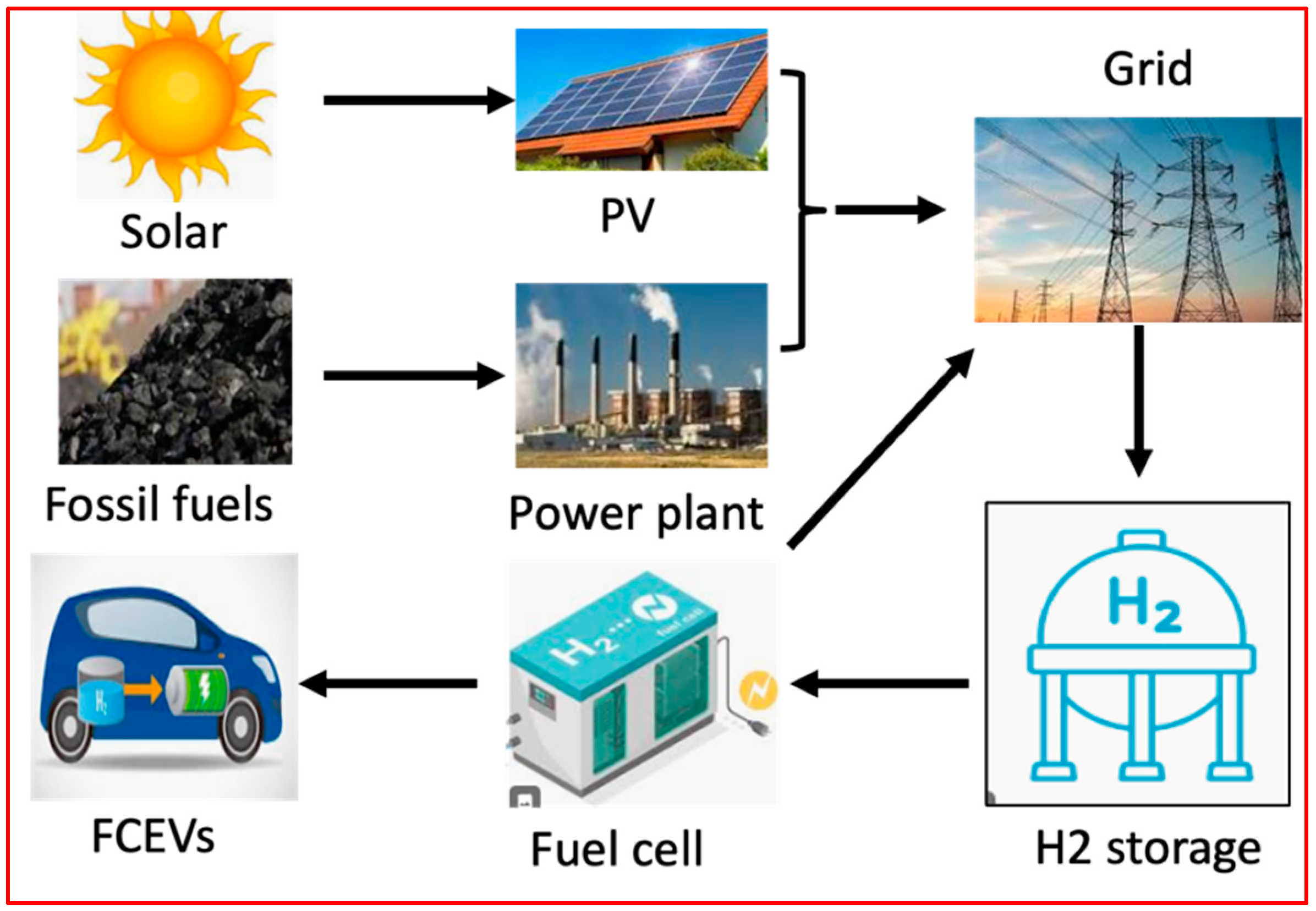
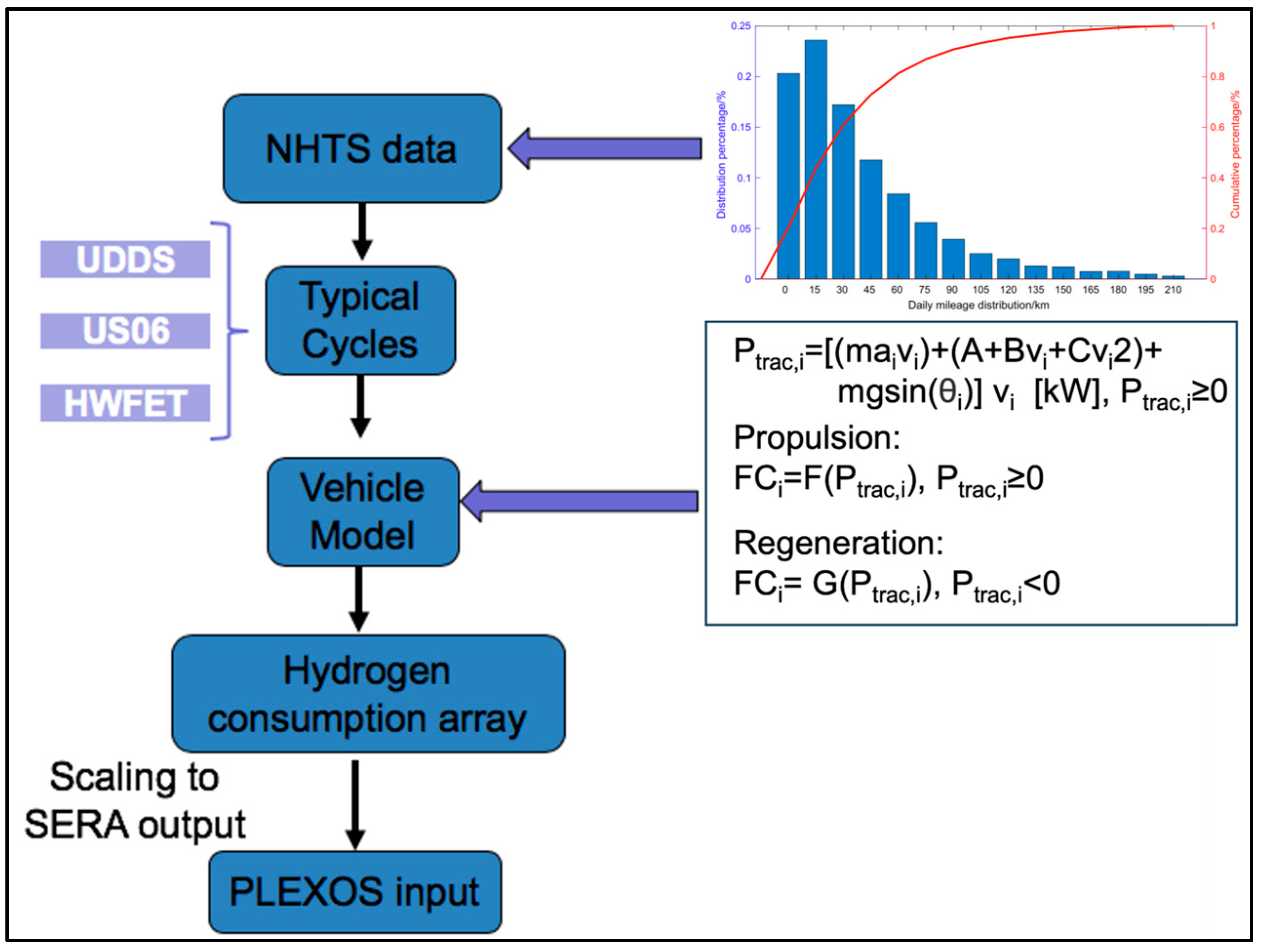
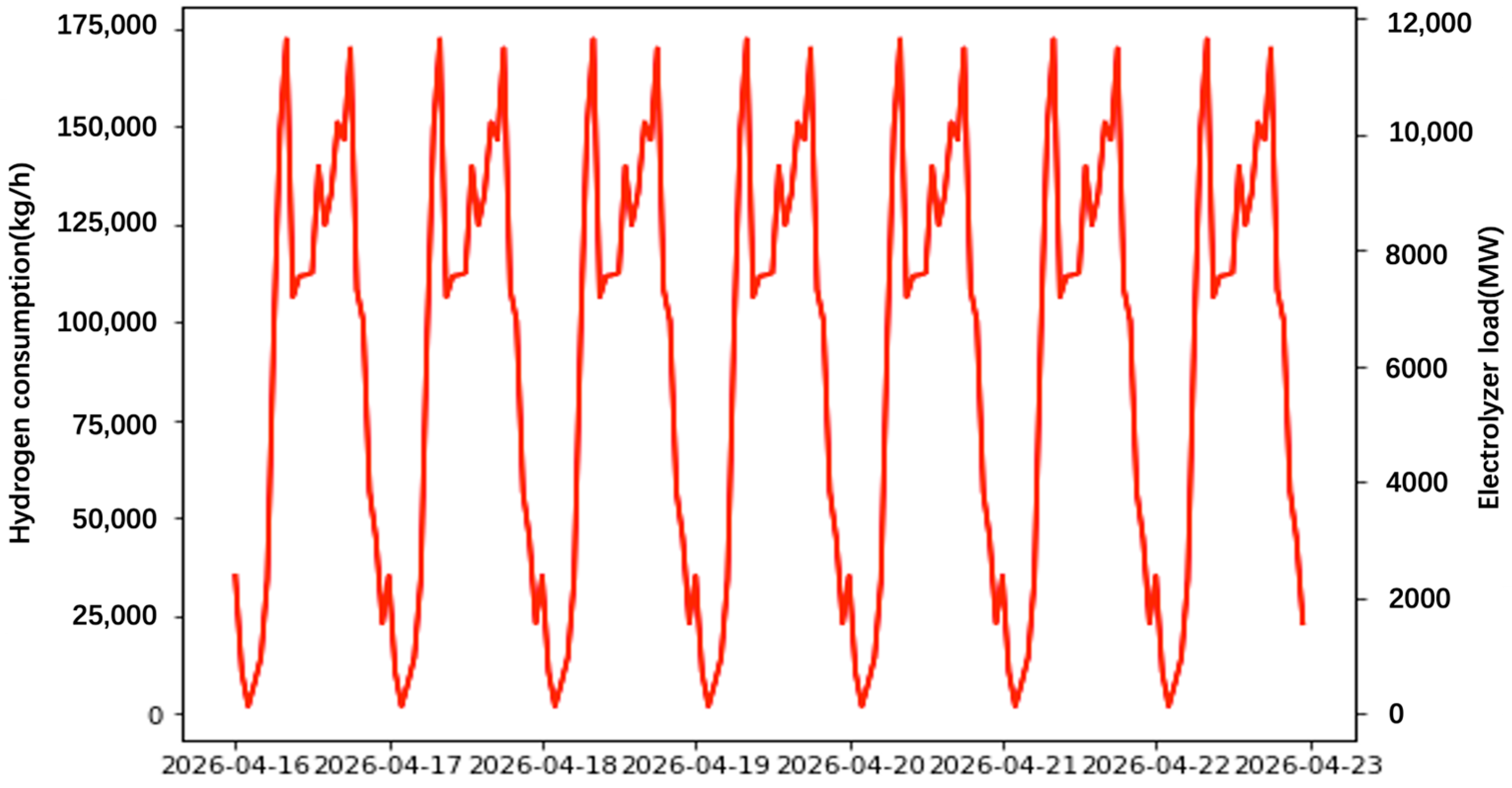
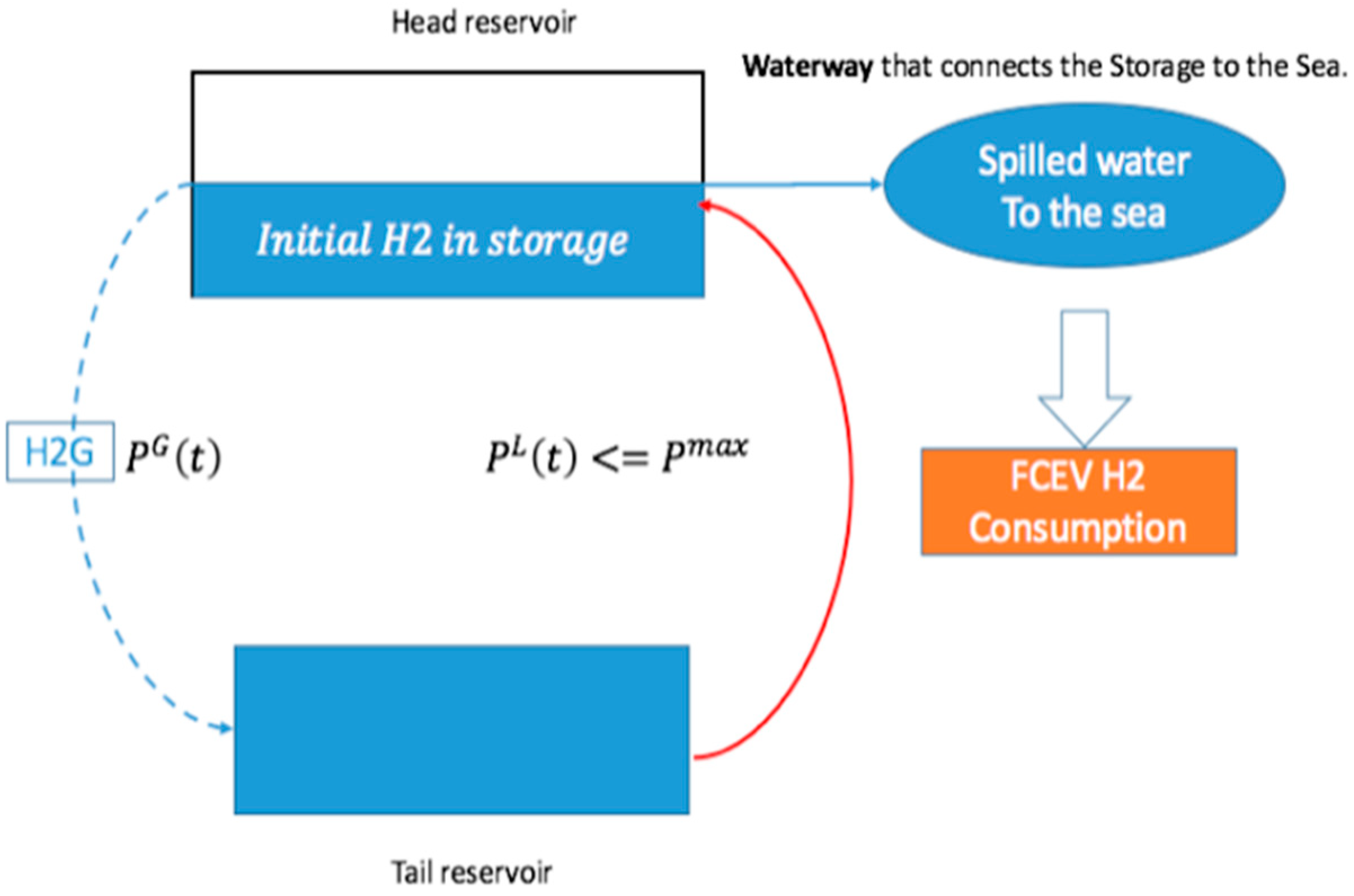


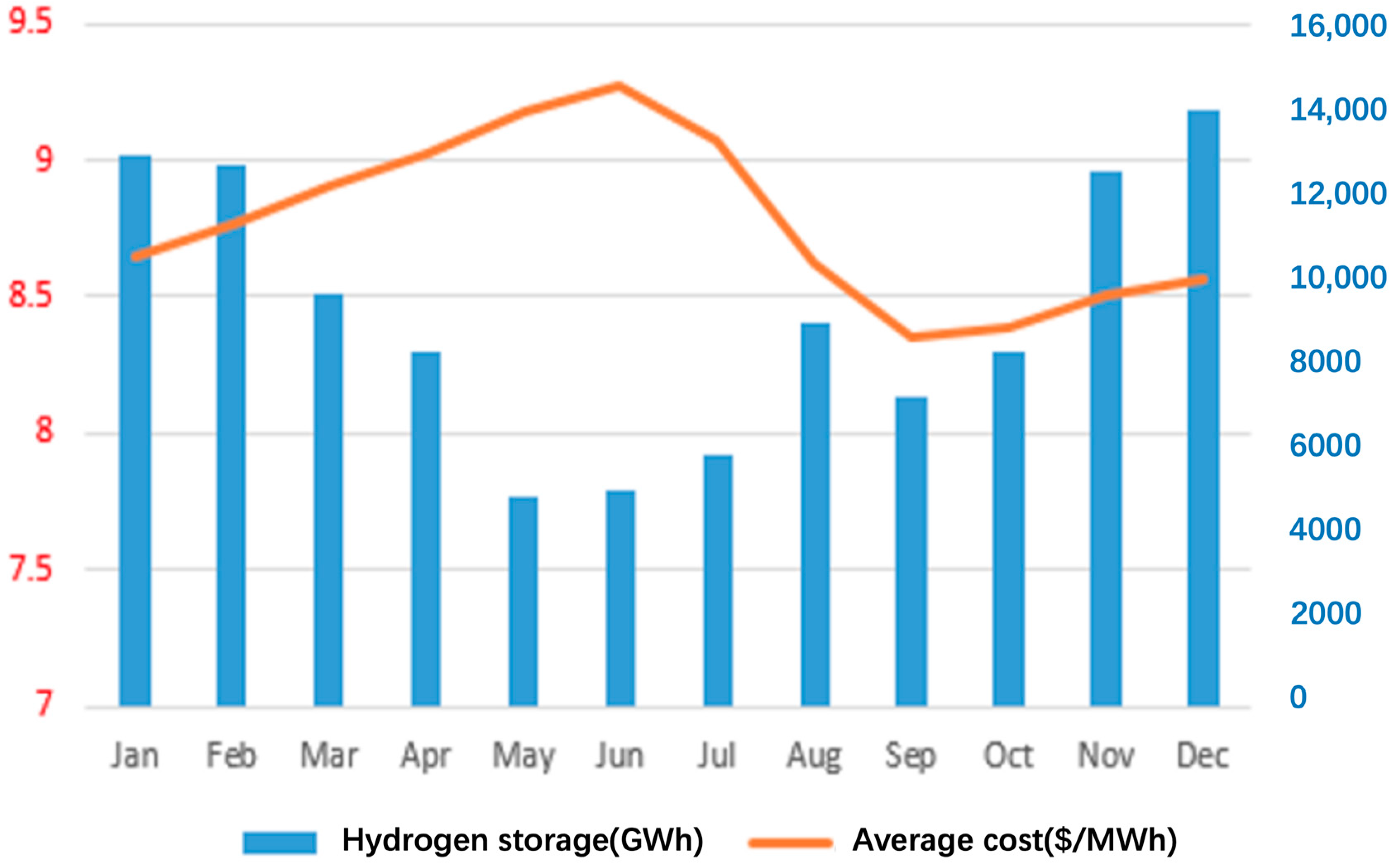
| State | Average Monthly Household Electricity Load (kWh) | Average Price (cents/kWh) |
|---|---|---|
| Hawaii | 505 | 27.47 |
| Alaska | 590 | 20.3 |
| Connecticut | 711 | 20.01 |
| Massachusetts | 599 | 19 |
| Rhode Island | 586 | 18.62 |
| New Hampshire | 604 | 18.38 |
| Oklahoma | 1093 | 10.2 |
| North Dakota | 1046 | 10.16 |
| Idaho | 953 | 9.95 |
| Arkansas | 1083 | 9.92 |
| Washington | 955 | 9.48 |
| Louisiana | 1240 | 9.34 |
Disclaimer/Publisher’s Note: The statements, opinions and data contained in all publications are solely those of the individual author(s) and contributor(s) and not of MDPI and/or the editor(s). MDPI and/or the editor(s) disclaim responsibility for any injury to people or property resulting from any ideas, methods, instructions or products referred to in the content. |
© 2025 by the authors. Licensee MDPI, Basel, Switzerland. This article is an open access article distributed under the terms and conditions of the Creative Commons Attribution (CC BY) license (https://creativecommons.org/licenses/by/4.0/).
Share and Cite
Zhang, C.; Shan, Y.; Lian, J.; Zhang, C.; Li, M. Optimizing Hydrogen Production for Sustainable Fuel Cell Electric Vehicles: Grid Impacts in the WECC Region. Sustainability 2025, 17, 1129. https://doi.org/10.3390/su17031129
Zhang C, Shan Y, Lian J, Zhang C, Li M. Optimizing Hydrogen Production for Sustainable Fuel Cell Electric Vehicles: Grid Impacts in the WECC Region. Sustainability. 2025; 17(3):1129. https://doi.org/10.3390/su17031129
Chicago/Turabian StyleZhang, Cong, Yuqian Shan, Jingchao Lian, Chuanfang Zhang, and Ming Li. 2025. "Optimizing Hydrogen Production for Sustainable Fuel Cell Electric Vehicles: Grid Impacts in the WECC Region" Sustainability 17, no. 3: 1129. https://doi.org/10.3390/su17031129
APA StyleZhang, C., Shan, Y., Lian, J., Zhang, C., & Li, M. (2025). Optimizing Hydrogen Production for Sustainable Fuel Cell Electric Vehicles: Grid Impacts in the WECC Region. Sustainability, 17(3), 1129. https://doi.org/10.3390/su17031129






